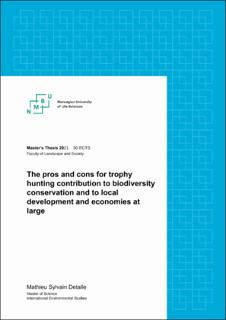| dc.contributor.advisor | Larsen, Thor | |
| dc.contributor.advisor | Grimsby, Lars Kåre | |
| dc.contributor.author | Detalle, Mathieu Sylvain | |
| dc.date.accessioned | 2021-12-21T10:44:56Z | |
| dc.date.available | 2021-12-21T10:44:56Z | |
| dc.date.issued | 2021 | |
| dc.identifier.uri | https://hdl.handle.net/11250/2835222 | |
| dc.description.abstract | Trophy hunting is a controversial topic. On one hand, opponents of trophy hunting
denounce an unethical practice, killing the same animals that are supposed to be protected while the benefits are reaped by wealthy private actors. On the other hand, proponents of trophy hunting argue that by generating revenues, it can then provide much needed incentives for wildlife conservation and management as well as socio-economic benefits for local communities, private landowners and national economies at large. This research aims to provide an understanding of the factors that influence trophy hunting’s sustainability and its contribution to wildlife and biodiversity conservation and national and local economies. By analysing related governance systems using the environmental governance systems (EGS) and legitimacy framework outlined by Vatn (2015), are used to understand actors interests and perceptions of trophy hunting, how they view and interact with each other, and highlight where and which improvements can be done in such systems. This research also assesses the role of institutions and policies in local participation in CBNRM programmes as locals have a key role in successful biodiversity conservation initiatives.
Based on secondary data collected through a qualitative literature review, results have
identified major factors which influence trophy hunting’s potential and credibility as a
conservation and development tool. Top-down management approaches which do not include all actors, especially locals in the decision making process and where power, revenues and benefits are unevenly distributed; bad governance and weak institutions related issues such as corruption, mismanagement and illegal hunting; and the disregard of hunting quotas and required biological characteristics as well as the absence of population’s monitoring undermine the practice of trophy hunting. On the other hand, bottom-up approaches with inclusion of local communities in decision making process and the recognition of their land and user rights; governance systems with strong institutions and policies as well as legitimacy and power devolution are important prerequisites which allow trophy hunting to contribute to conservation and development. This research also raised the question of how much power and influence international institutions should have on the management of natural resources by countries and
their governments. | en_US |
| dc.language.iso | eng | en_US |
| dc.publisher | Norwegian University of Life Sciences, Ås | en_US |
| dc.rights | Navngivelse-Ikkekommersiell-DelPåSammeVilkår 4.0 Internasjonal | * |
| dc.rights.uri | http://creativecommons.org/licenses/by-nc-sa/4.0/deed.no | * |
| dc.subject | Trophy hunting | en_US |
| dc.subject | Environmental governance | en_US |
| dc.subject | Community-based natural resource management | en_US |
| dc.subject | Sustainability | en_US |
| dc.subject | Legitimacy | en_US |
| dc.subject | Conservation | en_US |
| dc.subject | Socio-economic development | en_US |
| dc.title | The pros and cons for trophy hunting contribution to biodiversity conservation and to local development and economies at large | en_US |
| dc.type | Master thesis | en_US |
| dc.description.localcode | M-IES | en_US |

